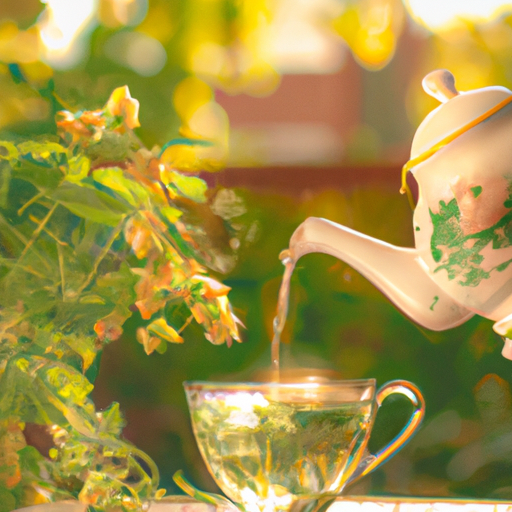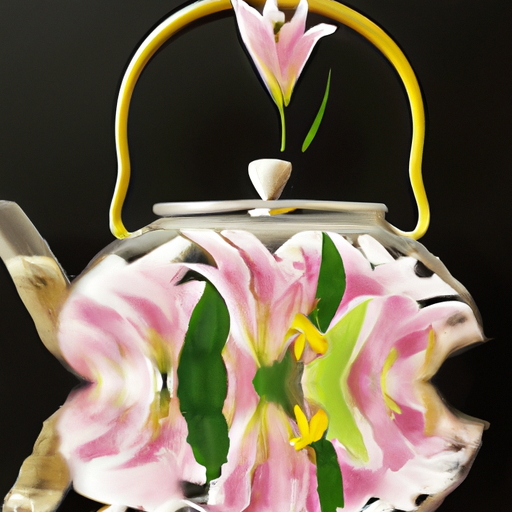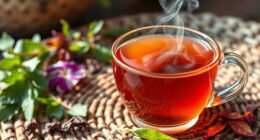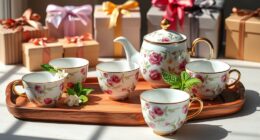I know what you’re thinking. Hops flower tea? Isn’t that the ingredient used in beer? Well, yes, it is. But did you know that hops flowers can also be brewed into a delightful and soothing tea? It’s true!
Now, you might be wondering why anyone would want to drink hops flower tea. Well, let me tell you, the health benefits are astounding. Not only does it help promote relaxation and reduce anxiety, but it also aids in digestion and supports a healthy sleep cycle. Plus, it’s packed with antioxidants, making it a great addition to your daily wellness routine.
But how do you make hops flower tea? Don’t worry, I’ve got you covered. In this article, I’ll walk you through the process step by step. From gathering the ingredients and tools to preparing the hops flowers and exploring different brewing methods, you’ll have all the knowledge you need to brew the perfect cup of hops flower tea.
So grab your favorite mug and let’s get started!
Key Takeaways
- Hops flower tea offers various health benefits, including relaxation, anxiety reduction, digestion support, and antioxidant properties.
- The necessary ingredients for making hops flower tea include fresh or dried hops flowers, filtered or spring water, a tea infuser or strainer, and a clean teapot or kettle.
- There are two main brewing methods for hops flower tea: hot infusion and cold infusion. The cold infusion method retains more delicate flavors and aromas compared to the hot infusion method.
- Proper storage techniques for hops flowers and hops flower tea include keeping them airtight, in a cool and dark place, and avoiding temperature fluctuations. Labeling and dating the container can help keep track of freshness.
Introduction to Hops Flower Tea
If you’re looking to explore new flavors and experience a calming sensation, you can easily brew hops flower tea in the comfort of your own kitchen. Hops flower tea is a unique beverage that not only offers a delightful taste but also provides numerous health benefits.
Hops, scientifically known as Humulus lupulus, are the female flowers of the hop plant. These flowers have been used for centuries in brewing beer, but they can also be brewed into a delicious and soothing tea. The history of hops tea dates back to ancient times, where it was primarily used for its sedative properties. The calming effect of hops flower tea is attributed to a compound called xanthohumol, which promotes relaxation and reduces anxiety.
In addition to its relaxing properties, hops flower tea offers a range of health benefits. It’s known to have antioxidant and anti-inflammatory properties, which can help protect against chronic diseases. Hops tea is also believed to improve sleep quality, relieve menopausal symptoms, and aid in digestion.
Understanding the health benefits of hops flower tea is crucial for those seeking a natural and soothing beverage option. By incorporating this herbal tea into your daily routine, you can experience the calming effects and promote overall well-being.
Understanding the Health Benefits of Hops Flower Tea
Exploring the numerous health benefits of hops flower tea will surely leave you hopping with excitement. Hops flower tea not only offers a delightful aroma but also provides a range of potential health advantages. This herbal infusion is known for its calming properties, making it an excellent choice for those seeking relaxation and relief from anxiety. The soothing effects of hops flower tea can also help with insomnia, promoting a good night’s sleep.
To understand the potential side effects of hops flower tea, it is important to note that it may cause drowsiness and should be consumed in moderation. Additionally, individuals with depression or hormone-related disorders should consult with a healthcare professional before incorporating this tea into their routine.
Let’s take a closer look at the aroma and taste of hops flower tea. The fragrance is often described as floral and earthy, with a hint of bitterness. When brewed, it produces a golden-colored infusion that has a mild, herbal taste. Some may find the bitterness overpowering, but others enjoy its unique flavor profile.
Now that we have a better understanding of the health benefits and aroma of hops flower tea, let’s move on to the next section and explore how to gather the necessary ingredients and tools.
Gathering the Ingredients and Tools
To fully enjoy the benefits of hops flower tea, it’s essential to gather all the necessary ingredients and tools. Here’s what you’ll need:
-
Fresh or dried hops flowers: Look for high-quality flowers that are vibrant in color and have a strong aroma. You can either grow your own hops or purchase them from a reputable supplier.
-
Water: Use filtered or spring water to ensure the best taste. Avoid using tap water, as it may contain impurities that can affect the flavor of the tea.
-
Tea infuser or strainer: This will help separate the hops flowers from the tea once it’s brewed. Choose a sturdy infuser or strainer that can hold the flowers without any leakage.
-
Teapot or kettle: A teapot or kettle with a spout is ideal for brewing hops flower tea. Make sure it’s clean and free from any residue that could alter the taste of the tea.
Now that you have all the necessary ingredients and tools, it’s time to move on to preparing the hops flowers for brewing. Remember, the key to a flavorful cup of hops flower tea lies in the proper preparation of the flowers.
Preparing the Hops Flowers
Now that you’ve gathered all the necessary ingredients and tools, let’s dive into the delightful process of transforming these vibrant blossoms into a cup of pure bliss. To prepare the hops flowers for tea, we need to go through a drying process to preserve their flavor and unlock their medicinal properties.
First, gently rinse the hops flowers under cool water to remove any dirt or debris. Pat them dry with a clean towel and spread them out on a clean, dry surface. It’s important to dry the flowers in a well-ventilated area away from direct sunlight to retain their vibrant colors and delicate aroma.
To speed up the drying process, you can use a food dehydrator set to a low temperature. This ensures that the hops flowers dry evenly without losing their valuable compounds. Alternatively, you can hang the flowers upside down in small bunches, allowing them to air dry naturally over a period of one to two weeks.
Once the hops flowers are completely dried, store them in an airtight container away from moisture and heat. This will preserve their freshness for months to come.
Now that the hops flowers are ready, let’s move on to the exciting world of brewing methods for hops flower tea.
Brewing Methods for Hops Flower Tea
When it comes to brewing hops flower tea, there are two main methods that I find most effective: the hot infusion method and the cold infusion method.
The hot infusion method involves steeping the hops flowers in hot water for a certain period of time to extract their flavors and aromas.
On the other hand, the cold infusion method requires a longer steeping time in cold water, which results in a milder and more refreshing tea.
Both methods have their own unique benefits and can be tailored to suit personal preferences.
Hot Infusion Method
Although many people claim that the hot infusion method brings out the best flavors in hops flower tea, further research is needed to verify this popular belief.
Hops flower tea is known for its numerous benefits, including its ability to improve sleep, reduce anxiety, and promote relaxation.
When brewing hops flower tea using the hot infusion method, it’s important to use high-quality dried hops flowers and filtered water for the best results. Start by boiling water and placing the hops flowers in a teapot or infuser. Pour the hot water over the flowers and let it steep for about 5-7 minutes. This allows the flavors and aromas to fully develop. After steeping, strain the tea and enjoy its soothing and calming effects.
Moving on to the cold infusion method, it offers a different way to extract the flavors from hops flowers, resulting in a refreshing and milder taste.
Cold Infusion Method
The cold infusion method creates a delightfully crisp and invigorating beverage that’ll leave you feeling refreshed and rejuvenated.
- Cold infusion benefits:
- Retains more delicate flavors and aromas compared to hot infusion.
- Extracts fewer tannins and bitterness, resulting in a smoother taste.
- Preserves more of the tea’s nutritional content, such as vitamins and antioxidants.
As an alternative brewing method, cold infusion offers a unique way to enjoy the distinct flavors of hops flower tea. By steeping the flowers in cold water for an extended period, the tea develops a subtle sweetness and a gentle floral aroma. This method is perfect for hot summer days when you desire a cooling and thirst-quenching beverage.
Now, let’s explore how to enhance the flavor of hops flower tea without compromising its delicate nature.
Enhancing the Flavor of Hops Flower Tea
To enhance the flavor of hops flower tea, you can add a teaspoon of honey, which not only adds sweetness but also enhances the floral notes of the tea. Did you know that adding honey to tea can also provide a boost of antioxidants? Honey has been used for centuries as a natural sweetener and flavor enhancer, and it pairs perfectly with the delicate and earthy taste of hops flower tea.
Not only does adding honey enhance the flavor, but it also enhances the aroma of the tea. The combination of the floral notes from the hops flowers and the sweet aroma of honey creates a truly delightful sensory experience. It’s like taking a walk through a blooming garden while savoring a cup of tea.
In addition to the flavor and aroma benefits, honey also brings along its own health benefits. It’s known for its antibacterial and anti-inflammatory properties, which can support a healthy immune system. Furthermore, honey is rich in antioxidants, which can help protect the body against oxidative stress and reduce the risk of chronic diseases.
By adding a teaspoon of honey to your hops flower tea, you not only enhance the flavor and aroma but also enjoy the added health benefits. Now, let’s move on to the next section and discover the best ways to serve and enjoy this delightful tea.
Serving and Enjoying Hops Flower Tea
Get ready to savor the delightful experience of serving and enjoying a cup of hops flower tea in the most delightful way possible! When it comes to serving hops flower tea, there are a few suggestions that can enhance your overall experience.
First, consider using a clear glass teapot or cup to showcase the beautiful color of the tea. This not only adds visual appeal but also allows you to appreciate the delicate aroma that emanates from the tea. Additionally, you can experiment with adding a slice of lemon or a sprig of mint to enhance the flavor profile of the tea.
Apart from its delightful taste, hops flower tea also offers numerous health benefits. It’s known for its calming properties, making it a perfect drink to enjoy before bedtime. It can help alleviate anxiety and promote relaxation. Moreover, hops flower tea is believed to have antioxidant properties that can boost the immune system and protect against certain chronic diseases.
As you finish your cup of hops flower tea, you may find yourself wondering about other ways to incorporate this versatile ingredient into your daily routine. In the next section, we’ll explore the various uses of hops flowers beyond tea.
Exploring Other Uses for Hops Flowers
Discover new and exciting ways to incorporate the versatility of hops flowers into your daily routine, and let your imagination run wild with the endless possibilities they offer. Hops flowers are not just limited to making tea; they can be utilized in various other ways, both for medicinal purposes and culinary applications.
When it comes to exploring the medicinal uses of hops flowers, they are known for their calming and sedative properties. They can be used to make a soothing herbal infusion that promotes relaxation and helps with sleep disorders. Additionally, hops flowers are believed to have anti-anxiety and anti-inflammatory effects, making them a valuable ingredient in natural remedies.
In terms of culinary applications, hops flowers can add a unique and distinct flavor to your dishes. They can be used as a spice or a garnish to enhance the taste of soups, stews, and sauces. Hops flowers can also be infused into oils or vinegar to create flavorful dressings or marinades for meats and vegetables. The possibilities are truly endless when it comes to incorporating hops flowers into your cooking.
As you explore the many uses of hops flowers, it is important to consider how to store and preserve them to maintain their freshness and potency. Without writing ‘step,’ let’s move on to the next section about storing and preserving hops flowers.
Storing and Preserving Hops Flowers
When it comes to storing and preserving hops flowers, there are a few key points to keep in mind. Proper storage techniques are essential in order to maintain the flavor and aroma of the hops. By following these techniques, you can extend the shelf life of the hops flowers and ensure that they remain fresh and potent for future use.
Proper Storage Techniques
To ensure the freshness and potency of your hops flower tea, make sure to properly store it. Proper storage techniques are crucial in preventing spoilage and maintaining the quality of your tea. Here are some tips to help you store your hops flowers effectively:
-
Keep it airtight: Store your hops flowers in an airtight container to protect them from moisture and air exposure.
-
Store in a cool, dark place: Exposure to heat and light can degrade the quality of hops flowers. Store them in a cool, dark place like a pantry or cupboard.
-
Avoid temperature fluctuations: Fluctuations in temperature can cause condensation, leading to spoilage. Keep the storage area consistently cool.
-
Label and date: To keep track of freshness, label the container with the date of purchase or harvest.
By following these proper storage techniques, you can extend the shelf life of your hops flower tea and enjoy its delightful flavors for longer periods of time.
Extending the Shelf Life
By properly storing your hops flower tea, you can preserve its freshness and flavors, allowing it to bloom and thrive like a delicate flower in a hidden garden. Extending the shelf life of hops flower tea is essential to ensure you can enjoy its delightful taste for longer periods. Here are some tips to help you preserve its freshness:
-
Store in an airtight container: Transfer the hops flower tea into airtight containers to protect it from exposure to air, moisture, and light.
-
Keep it in a cool, dark place: Store the tea away from direct sunlight and heat sources, as they can accelerate the degradation process.
-
Avoid strong odors: Keep the tea away from strong-smelling substances, as it can absorb unwanted aromas.
By following these storage techniques, you can extend the shelf life of your hops flower tea and preserve its freshness for a longer time.
In the next section, we’ll discuss the conclusion and final thoughts on hops flower tea.
Conclusion and Final Thoughts on Hops Flower Tea
Overall, I must say that hops flower tea is a delightful and soothing herbal beverage that I highly recommend trying. After exploring the various aspects of making and extending the shelf life of hops flower tea, I’ve come to some final thoughts and assessments regarding its benefits.
Firstly, hops flower tea is known for its calming properties and has been used for centuries to aid in sleep and relaxation. The natural compounds found in hops flowers, such as alpha acids and essential oils, contribute to its sedative effects. This makes it a great option for those struggling with insomnia or anxiety.
Additionally, hops flower tea is believed to have anti-inflammatory properties, which can help to reduce pain and swelling in the body. It also contains antioxidants that can protect against cell damage and promote overall health.
In terms of taste, hops flower tea has a unique flavor profile that’s both bitter and slightly floral. It may not be to everyone’s liking, but for those who enjoy herbal teas, it can be a refreshing and comforting choice.
Hops flower tea is a wonderful herbal beverage that offers a range of benefits. Whether you’re looking to relax, reduce inflammation, or simply enjoy a delicious cup of tea, hops flower tea is definitely worth a try. So go ahead, brew yourself a cup and experience the soothing effects of this herbal delight.
Frequently Asked Questions
How long can hops flowers be stored before they lose their potency?
Hops flowers can be stored for up to one year before they start losing their potency. Proper storage is crucial in preserving their freshness and flavor.
To ensure their longevity, store hops flowers in an airtight container in a cool, dark place. Avoid exposure to light, heat, and moisture as they can degrade the hops’ quality. By following these guidelines, you can maintain the potency of hops flowers for an extended period, allowing you to enjoy their benefits in various preparations.
Can hops flower tea help with insomnia?
Hops flower tea can indeed help with insomnia. It’s been found to have a calming effect on the body, reducing anxiety and promoting relaxation. To maximize its sleep benefits, it’s best to drink hops flower tea in the evening, preferably around 30 minutes before bedtime.
This allows the natural compounds in the tea to take effect, helping you achieve a restful night’s sleep.
Are there any potential side effects or interactions of hops flower tea with medications?
Hops flower tea, like any medication or herbal remedy, can have potential side effects and interactions with certain medications. It’s important to be aware of these before consuming it.
The side effects of hops flower tea may include drowsiness, dizziness, and stomach upset. Additionally, it may interact with sedatives, antidepressants, and anti-anxiety medications, intensifying their effects.
It’s always advisable to consult with a healthcare professional before incorporating hops flower tea into your routine to ensure its safety and effectiveness.
Can hops flower tea be made with dried hops flowers instead of fresh ones?
Yes, hops flower tea can be made with dried hops flowers instead of fresh ones. Using dried hops flowers is a convenient option, as they’re readily available and can be stored for a longer period. The benefits of hops flower tea remain the same whether made with fresh or dried flowers. It’s known for its calming properties and potential health benefits, such as aiding with sleep, reducing anxiety, and promoting relaxation.
Can hops flower tea be consumed by pregnant or breastfeeding women?
Safety precautions should be taken when considering the consumption of hops flower tea during pregnancy or while breastfeeding. While hops are generally considered safe in small amounts, it’s recommended to consult with a healthcare professional before incorporating it into your diet.
Hops flower tea may have potential health benefits, such as promoting relaxation and aiding in sleep. However, due to its potential effects on hormonal balance, it’s important to exercise caution and seek guidance from a healthcare provider.
Conclusion
After exploring the various uses and benefits of hops flower tea, I can confidently say that it’s a must-try for any tea lover. The combination of its calming properties and unique flavor make it a delightful beverage to enjoy at any time of day.
By following the simple steps outlined in this article, you can easily prepare and brew your own hops flower tea. Whether you choose to savor it hot or cold, this tea is sure to leave you feeling refreshed and revitalized.
So go ahead, give hops flower tea a try and experience its soothing effects for yourself. Cheers to a cup of tranquility!










